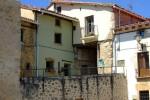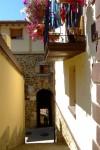The tamed sun of late August, a few summer clouds and a Northwestern breeze entice me to take the moborbike for a day tour. I don’t know where the wheels will take me: I just pick a road and let Rosaura guide me. Astride on her saddle, I ride on the road that runs along the once camino real towards Campezo and Estella over the Azaceta mountain pass.
The fast road bends trigger my adrenaline while I check, risking a skid, the holding of the tyres. I’m writing this, therefore I had some scope yet for leaning.
Once on the south slope, after a few connected bends, behold a Renaissance scenery: to the left, bouncing to the sky the oblique sunrays of noon, the ancient roofs and walls of Antoñana stand out against the green background of a grove. At once I understand that this was my today’s destination.

Antoñana’s warlike side
To my right, some government has erected a museum to the old vasco-navarro railroad; but I don’t care much and I get my bearings to the slope climbing to the knoll whereupon the village settles: on a strategic enclave within the borderlands between Navarra and Castilla, upon the meeting of two main tracks, Antoñana was founded during the deep Midel Ages as a fortified borough, on top of an ancient fortress about whose origins not much is known, except through its name, Antoñana: during the Roman times, some Antonius must have had his country estate there.
-

- Muralla
-

- Torre suroeste
-

- Vista exterior del lado suroeste. Una entrada secundaria a través de un pasadizo.
-

- Las casas extramuros.
-

- Muralla norte.

I leave my mount under History’s shadow.
I park Rosaura by a wall, walk under the lancet arch gate and begin to go round the borough’s archaic layout. Today there’s some weekend atmosphere: the pub is full of people, some kids are playing a ball by the frontón while some others seek and hide throughout the passages, lanes and dark winding alleys, which give them endless ground for their rushabouts. A truck’s lundspeaker sells juicy Calanda peaches.
Because of the struggles between both kingdoms, Navarra and Castille, since XIst century these lands used to shift hands from crown to crown. On 1182, the king of Navarra Sancho “the wise” fortifies Antoñana and grants it the Privilege. Only twenty years later, the garrison becomes once more Castillian, this time for good, under the rule of Alfonso VIIIth. Since then, and to our era, it has belonged to Castilla.
In those times, the province of Álava was a battleground where, overlapping the wars between both kingdoms, the local feudal families settled their fights over and over for generations. The lordly families of Ayala, Orozco and Velasco split their blood and paid some lives in episodes ranging from night ambushes to plain pitched battle. Alike Capulets and Montagues, the Mendozas and Guevaras fought among themselves for over a century. These slaughters came to an end when the Mendoza lineage, of Navarra, passed to serve Castilla in XIVth century. In that atmosphere of internecine struggles, Antoñana was unattached to any lord until in 1367 was subjected to Rui Díaz de Rojas by gift from Enrique Trastámara the IInd; and one century later the borough passed to serve the lineage of Hurtado de Mendoza, whose jurisdiction was argued by its residents for decades, until, eventually, they paid to the Crown for buying the end of their serfdom.

Main gate in the south end. The right wall is the church’s, which originally was also a fortress.
Upon stepping across its south gate, I come across the church of San Vicente Mártir, built on top of a former fortress-church. The ashlars make a contrast with the wall’s masonry whereto it leans. Some girls, oblivious to history, play along wrought-iron gate’s bars, under the shady and secluded XVIIIth century portico, filling with childlike echoes, merry and everlasting, the place’s vaults.
-

- Iglesia
-

- Detalle del campanario.
-

- Pórtico
-

- Cancela
-

- Torre de la iglesia
Then I scouth with fascination and awe the ancient streets with their matchless and authentic medieval flavour; the period’s features remain present, giving the village a classic warlike look; and, but for the inevitable signs of contemporary life, I’d thought I went back nine centuries: the three main parallel streets, connected through passages, lanes and alleys; the castle-houses, the tower-strongholds, the coats of arms, stone all over…
-

- Paso porticado entre dos calles
-

- Callejón entre dos calles principales
-

- Soportales
-

- Soportal
-

- Soportal junto a la plaza
-

- Cantón entre dos calles
-

- Pasadizo entre dos calles
-

- Espléndida vista al salir de un pasadizo
-

- Una de las tres calles principales paralelas
-

- Otra de las tres calles principales
Nowadays, contrasting with the grim and severe masonry of its old walls, there are also some colourful corners. Who knows? Maybe ten centuries ago women also decorated their houses with flower pots, whenever they could…
-

- Esquina florida
-

- Alegre vista sobre la ribera y el valle
-

- Pilar, lavadero y abrevadero
While scouting the borough, noon gave way to afternoon, people sought their homes and children faded away behind the mysterious corners or under the shadows of the arcades. I’m back to the main plaza. Some cars are gone, and there’s noone sitting at the pub’s tables. The waiter is clearing away. The sun pours a golden light upon the neighbouring hillside, at whose bottom lies the graveyard and the chapel. Rosaura is waiting for me at the walls foot, unshaded.

To the east, by the graveyard, the chapel of Nuestra Señora del Campo, built on top of the ramains of a former romanic chapel
Before saying farewell to Antoñana I take the customary drink and tapa of my tours. One per village. The pub’s waiter showes the typical Basque sullenness. I get served a chilled zurito (small beer) and a pincho of homemade tortilla (potatoes from the garden, countryside eggs). I enjoy it as if it was the first time in my life. Rather unexpensive, too.
It’s time to go. Jacket, helmet and gloves. I go down the street on a dead engine to the bridge over the creek and look back for the last time at the medieval borough. Now the sun is warming up its western wall, made useful and quaint by the houses. I start the motorcycle and, in a few seconds, the roar of the exhaust and the whistle of the wind in my helmet bring me back to XXIst century. The road is mine.
























